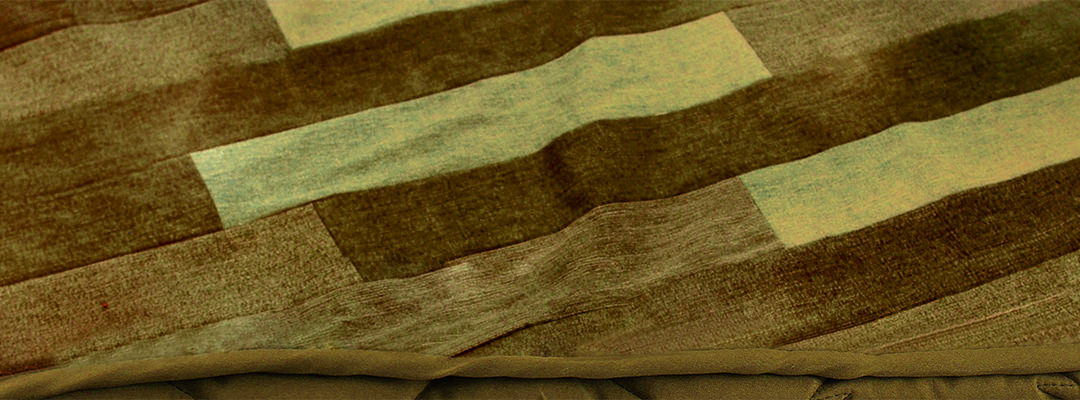The best kinds of crafts are ones that are simple to make, nice to look at, and serve a functional purpose that makes your everyday life better. Weighted blankets — also called “pressure therapy blankets” — can be all of these things.
If you haven’t heard of a weighted blanket before, don’t panic. They’re a major sleepwear trend that comes with a slew of health benefits, whether purchased from high street retailers or made at home. Let’s look at what is a weighted blanket, some of the health benefits of weighted blankets, and how to make your own loveable, snugglable DIY weighted blanket for yourself or a loved one.
What is a Weighted Blanket
A weighted blanket is what you would guess from the name on the tin — a blanket that’s weighed down either by heavy filling (we’ll talk about filling choices down below) or by a particularly dense weaving method. Since these blankets are going to be in direct contact with the skin, even more so than standard sleeping blankets, it’s essential that they be made from comfortable, sensually pleasant materials such as fleece or silk.
These weighted blankets hang heavier and “hug” the body as you rest or sleep, which can work wonders for the way we sleep and the way our brains work as we’re winding down.
Weighted Blanket Benefits
Because of their unusual construction and the way they wrap around the body, weighted blankets have been attributed to a number of benefits for the body and mind. Originally a niche treatment recommended by child health professionals, weighted blankets are being embraced by a huge range of people for their soothing, relaxing properties, which we’ll look at below.
Relieves Anxiety
Weighted blankets function based on a concept called “deep pressure stimulation”, or DPS (Sometimes called “deep touch pressure”, or DTP). This causes the brain to react in the same way it would if it were responding to a hug or a gentle touch from a loved one. DPS triggers a bunch of cool stuff in our brain, including:
- Increasing production of serotonin, or the “happiness chemical”. This is the same chemical that’s often targeted by antidepressant drugs, and it leads to a feeling of peace and well-being.
- Decreasing production of cortisol, or the “stress hormone”. When our stress levels get too high they can lead to heart problems, respiratory problems, and even sharp physical pain.
- Dialing down your autonomic nervous system, which is what launches you into fight-or-flight mode when you’re stressed. Weighted blankets put your body into “rest mode”, which smooths out your heart rate, blood pressure, and breathing.
One study proved that the grounding effect of a weighted mattress pad significantly reduced stress levels and encouraged deeper, more restful sleep. By using a weighted blanket, you’re gaming the stress system for some tranquil, science-backed R&R.
Supports ASD and ADHD Needs
Weighted blankets work well for people with sensory sensitivities, such as those with Autism Spectrum Disorder, Attention Deficit Disorder or Hyperactivity Disorder, because they focus the mind on the sense of touch. Having this as a sensory stimulus can help focus the brain away from other environmental distractions.
Studies have shown that the addition of a weighted clothing item can help people with ADHD focus better. Likewise, adults and children with autism can often be particularly sensitive to outside distractions. Using a weighted blanket during sleep or study can help keep the mind focused and stop it from running off in all directions. This is a huge help to people with ADHD and Autism Spectrum Disorder, but it can also be a benefit to just about anybody.
Relieves Chronic Pain
Cortisol, that same hormone that’s responsible for kicking up our stress levels, can turn pretty nasty when left unchecked. Factors like stress, anxiety, underlying medical conditions, working conditions, and posture can all lead to chronic pain issues. Because the causes of chronic pain are so varied, not everyone experiences it or responds to treatments in the same way. However, several studies have been done on the effects of weighted blankets on pain reduction and physiological anxiety over the long term.
In addition to reducing our stress and anxiety levels, as we looked at above, weighted blankets apply that deep pressure stimulation to our bodies as we’re falling asleep. Gentle pressure therapy has been shown to aid in alleviating chronic pain over time, and weighted blankets are a great way to continue that treatment slowly and softly as you sleep.
Better Sleep
Better sleep habits are the name of the game here at Sleep Underground, so we love anything that will help you snuggle into a deeper, more restful sleep. Weighted blankets have been shown to help with chronic sleep disorders by calming your heart rate, regulating your breathing, and reducing nighttime stress.
As we saw above, weighted blankets help improve the production of serotonin and decrease the production of cortisol. Using a weighted blanket also increases the production of melatonin, the hormone that helps your body wind down for the night. This combination of higher happiness levels, lower stress levels, and a more grounded physical body makes it easier to fall into a peaceful sleep. The extra weight is also beneficial to people who toss and turn a lot at night, as it encourages you to stay in place a bit more, which in turn leads to a more restful night’s sleep.
Weighted Blanket Precautions
Weighted blankets are a great asset to any nighttime routine, but are they the best choice for everybody? As with most things, there is no one right answer for every person.
While weighted blankets can be a great sleep aid for a lot of people, they’re not recommended for anyone with breathing difficulties, such as asthma or sleep apnea, as the extra weight can weigh on the lungs and make breathing even more troublesome. They’re also not always the best for someone who is claustrophobic or particularly sensitive to touching, because the extra pressure of the weighted blanket can begin to feel a bit intrusive. And lastly, never use a weighted blanket on small children under two years old. They’re difficult to move with Baby’s little arms and can pose a suffocation risk (use a swaddle blanket or sleep sack instead!).
How to Choose Materials for Your Weighted Blanket
Now that we’ve looked at some of the benefits to using a weighted blanket, are you ready to try making your own? Weighted blankets bought at high street shops can get pretty pricey (up into the hundreds of dollars); making your own is not only more affordable, but allows you to quality control each step of the process with your choice of materials.
Here are the materials you’re going to need for your DIY weighted blanket.
Outer Material
Decide how large you want your blanket to be, then double it with about an extra inch on each side for sewing. 52 x 60 inches on each side is a good place to start for most adults.
Depending on the fabric and filling material you want to use, you may choose to use the same material for the entire blanket or you may have an inner and an outer fabric. If you’re going to be using your blanket all the time, it’s essential that at least part of it be washable. Not all fillings can go in the wash, so if that’s the case it’s a good idea to have one fabric for the inner blanket and a second washable material to go around the outside, similar to a duvet cover. If you decide to go this route, give a few extra inches of space to the outer layer to make sure the inner blanket will fit comfortably inside.
For your outer layer, consider soft, natural materials such as cotton, linen, rayon, or silk. Fleece is a wonderful synthetic choice for a single-layer blanket as it’s strong and keeps you warm. Also think about colours, designs, and patterns that would compliment your sleeping space.
Lining Material
Warm, durable materials like fleece or wool are great for the inside of your blanket, both for keeping you warm and for keeping your weights in place. If you’re just using one material, make sure it’s something you can wash regularly. The fabric should be strong enough to keep the weights in place, thick enough to keep you warm, and soft enough to avoid any negative sensory sensitivity.
Filling
In general, weighted blankets should be about 10% of the sleeper’s total body weight. Therefore if the person using the blanket is 120 lbs, you want about 12 lbs of filling weight.
The most popular filling for a weighted blanket is small polycarbonate plastic beads. These pellets are inexpensive, hypoallergenic, easy to find at most craft stores, and, best of all, they’re fully machine washable. You can also find similar beads in glass, though these are less common.
The main concern with plastic or glass pellets, however, is that they can present a hazard for children and pets if any pieces fall out or go missing during the crafting process. If you’re worried about having small pieces around, or if you just don’t love the idea of plastic, you can choose a natural alternative like beans or grains to weigh your blanket. These are usually a little lighter so you’ll need to use a bit more of them.
However — this is important — these natural weights can’t handle any moisture at all. If you choose to use grains or beans in your weighted blanket it is essential that you pair it with a matching cover blanket, because the inner blanket won’t be able to go into the wash. Your cover will also help protect it from spills and humidity. If you’re worried about water coming in contact with your blanket, it’s best to choose a wash-proof filling like plastic or glass.
Optionally, you can also pair your filling beads with some fluffy cotton or stuffing. This is especially a good idea if the material you’ve chosen for your blanket is quite thin.
How to Make Your Own Weighted Blanket
Now that you’ve chosen your materials, let’s get started! Here’s everything you’re going to need.
Tools
- A sewing machine, or a heavy-duty needle (such as one made for denim) and some chutzpah
- A kitchen scale for accurately measuring your weights
- Measuring tape or a ruler
- Fabric-friendly marker or chalk
- Scissors
- Cups or bowls to keep your filling weight together in one place
- Buttons, velcro, zippers, or other closures for your outer layer (optional)
Materials
Your outer material, lining material, and filler as well as a strong matching thread. Make sure to have this all ready to go when you begin so you’re not running around going, where did I put that? Make sure you’ve calculated exactly how much you’ll need so you don’t need to stop and run back to the shop (or worse, wait for another Amazon delivery) halfway through the process.
Now you’ve got to do some math. After you’ve calculated how heavy you want your blanket to be (about 10% of your body weight, or the bodyweight of the person it’s intended for), decide how big you want each section to be. 5 x 5 inches is a good benchmark. Check out your blanket size and see how many sections you’re going to have in the whole thing — for example, if your finished blanket is going to be 52 x 60 inches, you can take the total area (52 x 60 = 3120 inches) divided by the area of each section (5 x 5 = 25 square inches), which gives you 124.8, or about 125 sections in total.
Now, you know you want your blanket to weigh 12 lbs, right (adjust for your intended body weight)? Easy. Take your 12 lbs and divide it by 125, which gives you the weight of filling you need to have in each individual section.
You can use a calculator if you like. Try to keep the weights more or less even, but they don’t need to be precise down to the umpteenth decimal. No stress.
Method
Begin by sewing three sides of your blanket inside out. This is your inner material, if you’re using two, or your main blanket if you’re sticking to one. Then turn the three-sided sack right side in. Now you’ve got a giant pillowcase.
Next you’re going to need your vertical channels. Go back to your calculations and figure out how many you need — if your blanket is 52 inches across and you’re making 5-inch squares, that’ll be 10-11 sections (with the outermost ones being a little bigger or a little smaller). You can measure these out with your measuring tape and mark them with fabric-friendly chalk or markers before sewing.
Now you get to start filling! How exciting! Go back to your measurements and remind yourself how much filling each square is going to hold. Pour some filling down each vertical chamber and give it a shake so it all settles to the bottom.
Then you’re going to sew your first horizontal line across all of the vertical chambers, sealing in the first line of weighted sections. Remember, this will be five inches up (if you’re making 5 x 5 sections; adjust as you feel comfortable with). Now you have some slightly shorter vertical chambers, which you’re going to fill with portioned weights just like you did the first time. Then, once each one is filled, gently shake the filling down to the bottom and sew your next horizontal seam across. Now you’ve got two rows of filled sections.
Got the hang of it? Keep going across your vertical chambers one row at a time, sealing off each row before moving on to the next one. When you reach the top, finish it with a neat and tidy seam to keep it all together. You can use whatever finishing technique you prefer as long as it’s secure.
If you’ve chosen to use one fabric for the blanket, this will be your last step. If you’ve made your weighted blanket unwashable and you need a second layer, you have one last job: sew the outer blanket. This part’s easy: just repeat step one with your outer layer material, sewing three sides inside out. Then, turn it right side in and shimmy it over your new weighted blanket. You can seal up the fourth side with buttons, snaps, velcro, or whatever closure method you prefer.
And that’s it! You’re done! Enjoy your next-level snoozes.
Did you like it?4.6/5 (27)





